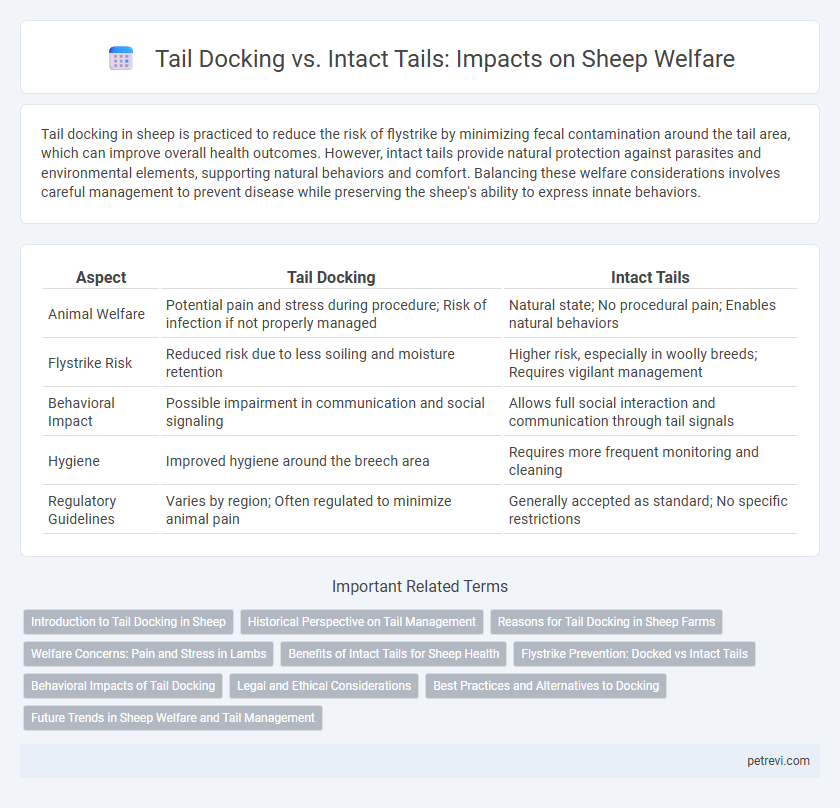Tail docking in sheep is practiced to reduce the risk of flystrike by minimizing fecal contamination around the tail area, which can improve overall health outcomes. However, intact tails provide natural protection against parasites and environmental elements, supporting natural behaviors and comfort. Balancing these welfare considerations involves careful management to prevent disease while preserving the sheep's ability to express innate behaviors.
Table of Comparison
| Aspect | Tail Docking | Intact Tails |
|---|---|---|
| Animal Welfare | Potential pain and stress during procedure; Risk of infection if not properly managed | Natural state; No procedural pain; Enables natural behaviors |
| Flystrike Risk | Reduced risk due to less soiling and moisture retention | Higher risk, especially in woolly breeds; Requires vigilant management |
| Behavioral Impact | Possible impairment in communication and social signaling | Allows full social interaction and communication through tail signals |
| Hygiene | Improved hygiene around the breech area | Requires more frequent monitoring and cleaning |
| Regulatory Guidelines | Varies by region; Often regulated to minimize animal pain | Generally accepted as standard; No specific restrictions |
Introduction to Tail Docking in Sheep
Tail docking in sheep involves the removal of part or all of the tail shortly after birth to prevent complications such as flystrike and improve hygiene. This practice varies in length and method but aims to reduce the risk of parasitic infections and accumulation of fecal matter around the hindquarters. Welfare concerns emphasize the balance between health benefits and pain management during the procedure.
Historical Perspective on Tail Management
Historically, tail docking in sheep was widely adopted to reduce the risk of flystrike caused by manure accumulation and moisture in the tail area. Traditional practices favored docking to improve hygiene and lower parasitic infestations, but modern animal welfare research questions its necessity given advances in management and breeding. Current trends emphasize maintaining intact tails to preserve natural behaviors and physiological functions while implementing integrated pest management strategies.
Reasons for Tail Docking in Sheep Farms
Tail docking in sheep farms is primarily performed to reduce the risk of flystrike, a painful condition caused by blowflies laying eggs in soiled wool around the tail area. This practice aims to improve hygiene by preventing fecal and urine accumulation, which attracts parasites and bacteria. Maintaining proper tail length can also facilitate easier inspection and treatment of sheep, contributing to overall flock health management.
Welfare Concerns: Pain and Stress in Lambs
Tail docking in lambs involves the removal of part of the tail to prevent flystrike, but it causes acute pain and stress due to tissue injury and nerve damage. Studies have shown elevated cortisol levels and behavioral signs of distress in docked lambs compared to those with intact tails. Maintaining intact tails preserves natural defense mechanisms without compromising welfare when proper management practices minimize flystrike risk.
Benefits of Intact Tails for Sheep Health
Intact tails in sheep play a crucial role in maintaining overall health by providing effective protection against environmental elements, parasites, and flystrike. They help in natural fecal shedding, reducing the risk of infections and inflammation around the perianal area. Preserving tails supports better thermoregulation and enhances natural behaviors critical for sheep welfare.
Flystrike Prevention: Docked vs Intact Tails
Flystrike prevention in sheep heavily influences the choice between tail docking and maintaining intact tails, as shorter docked tails reduce fecal accumulation that attracts flies, minimizing the risk of flystrike. Intact tails provide natural protection by aiding in the sheep's ability to flick away flies, but longer tails can harbor more moisture and dirt, increasing vulnerability. Effective flystrike prevention often involves balancing tail length with other management practices like shearing and hygiene to ensure optimal sheep welfare.
Behavioral Impacts of Tail Docking
Tail docking in sheep can lead to altered behavioral patterns such as increased restlessness, reduced grooming, and social withdrawal, indicating stress and discomfort. Intact tails allow for natural communication through tail movement, important for social bonding and predator awareness. Research suggests maintaining intact tails supports normal behaviors and improves overall welfare by reducing pain and related stress responses.
Legal and Ethical Considerations
Tail docking in sheep is regulated under animal welfare laws to prevent unnecessary pain and promote health, with many countries mandating procedures be performed by trained professionals using pain relief. Ethical considerations emphasize the balance between reducing risks of flystrike and potential discomfort, advocating for intact tails when possible to maintain natural behavior and protect nerve function. Legislative frameworks increasingly encourage alternatives to docking, reflecting evolving standards in animal welfare and ethical farming practices.
Best Practices and Alternatives to Docking
Tail docking in sheep, traditionally performed to reduce flystrike risk, raises welfare concerns due to pain and infection if done improperly; best practices emphasize pain management through analgesics and local anesthesia. Alternatives to docking include breeding for sheep with longer, wool-covered tails less prone to flystrike and maintaining excellent hygiene and parasite control. Managing pasture conditions and nutritional status also play critical roles in reducing flystrike incidence without resorting to tail docking.
Future Trends in Sheep Welfare and Tail Management
Emerging research in sheep welfare emphasizes the benefits of maintaining intact tails to reduce pain and improve natural behaviors, while advances in precision livestock farming enable more humane and individualized tail management practices. Innovations such as biodegradable tail bands and genetic selection for traits reducing flystrike susceptibility are gaining traction, signaling a shift towards welfare-friendly, non-invasive alternatives to traditional tail docking. The integration of real-time health monitoring technologies further supports proactive management strategies, enhancing overall sheep well-being and productivity in future livestock systems.
Tail Docking vs Intact Tails for Sheep Welfare Infographic

 petrevi.com
petrevi.com